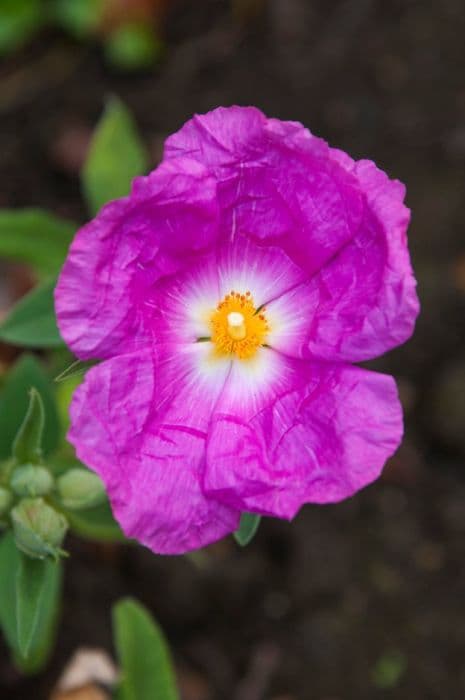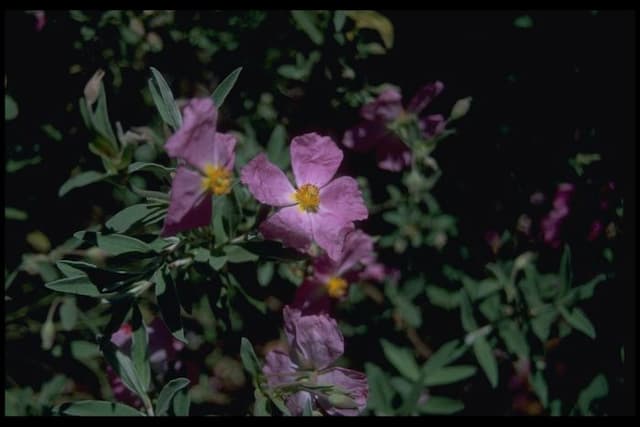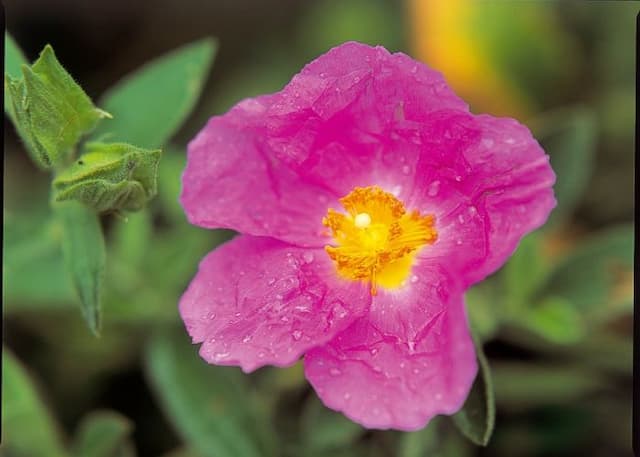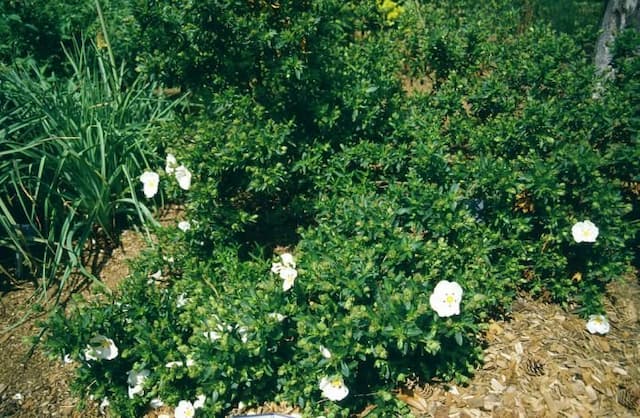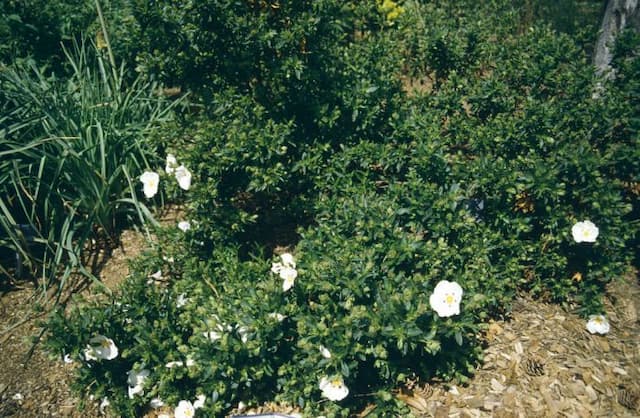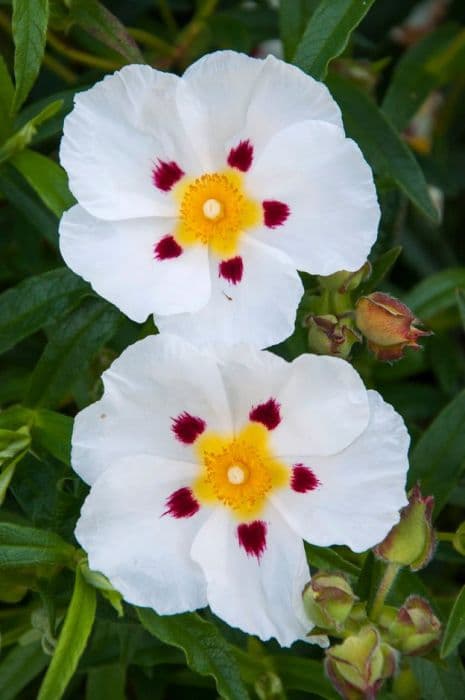Rock Rose Cistus × argenteus 'Silver Pink' ambig.

ABOUT
The 'Silver Pink' Rockrose is a striking evergreen shrub well-known for its decorative appeal. Its most distinctive feature is the profusion of saucer-shaped flowers that bloom in a soft, silvery-pink hue. Each flower displays a generous number of delicate petals that often possess a slightly crepe-like texture, which adds to the plant's overall elegance. Adding to the beauty of the flowers is the presence of prominent yellow stamens at their center, creating an attractive contrast against the pale pink petals. The foliage of the 'Silver Pink' Rockrose is equally appealing. The leaves are small to medium in size and sport a silvery-green coloration. They have a slightly hairy or fuzzy texture, which gives the foliage a greyish sheen, further enhancing the shrub's silvery appearance. The overall form of this Rockrose is bushy and rounded, with a dense growth habit. This trait makes it an excellent choice for creating a lush, full look in gardens. Its leaves and flowers cover the plant so profusely that it provides a robust display of color and texture, making it a favorite for adding visual interest to landscapes. Despite the exclusion of size, it is important to note that the plant's proportions contribute significantly to its ornamental value, allowing it to fit into various garden settings as an attractive feature.
About this plant
 Names
NamesFamily
Cistaceae
Synonyms
Rock Rose, Orchid Rockrose, Silver Pink Rockrose
Common names
Cistus × argenteus 'Silver Pink'
 Toxicity
ToxicityTo humans
Rockrose is generally considered non-toxic to humans. Therefore, ingestion of the plant typically does not lead to poisoning or adverse health effects.
To pets
Rockrose is not known to be toxic to pets either. It is unlikely to cause poisoning or significant health issues if pets consume parts of the plant.
 Characteristics
CharacteristicsLife cycle
Perennials
Foliage type
Evergreen
Color of leaves
Green
Flower color
Pink
Height
3 feet (0.91 meters)
Spread
3 feet (0.91 meters)
Plant type
Shrub
Hardiness zones
8
Native area
Mediterranean
Benefits
 General Benefits
General Benefits- Ornamental Value: Cistus × argenteus 'Silver Pink', commonly known as Rockrose, has striking silver-pink flowers and silver-frosted leaves, making it a beautiful addition to any garden.
- Drought Tolerance: Rockrose is extremely drought-resistant once established, making it ideal for xeriscaping and low-water gardens.
- Easy Maintenance: It requires minimal care, thriving in poor soil with little fertilization or pruning.
- Attracts Pollinators: The flowers attract bees, butterflies, and other pollinating insects, beneficial for garden biodiversity.
- Rapid Growth: Rockrose plants grow quickly, providing fast cover and filling in garden spaces efficiently.
- Erosion Control: Its root system helps stabilize slopes and can be used to prevent soil erosion in challenging landscapes.
- Deer Resistance: The plant is often deer-resistant, making it suitable for areas where deer predation is a concern for gardeners.
- Long Blooming Season: Rockrose blooms for a prolonged period from spring to summer, providing long-lasting visual interest.
- Low Allergenic: It’s considered to have low allergenic potential, which is a plus for people with pollen allergies.
- Mediterranean Adaptation: Being native to Mediterranean regions, this plant is well-suited to similar climates around the world.
 Medical Properties
Medical PropertiesThis plant is not used for medical purposes.
 Air-purifying Qualities
Air-purifying QualitiesThis plant is not specifically known for air purifying qualities.
 Other Uses
Other Uses- Cistus × argenteus 'Silver Pink', commonly known as Rockrose, can be used as a natural dye source for fabrics, imparting a range of colors when used in traditional dyeing techniques.
- The resin collected from Rockrose has been used in the perfume industry as a fixative, providing an aromatic, amber-like fragrance to perfumes.
- Rockrose is sometimes utilized in bonsai cultivation due to its attractive foliage and flowers, as well as its ability to withstand pruning and shaping.
- The plant contributes to erosion control, especially in dry and rocky areas, by establishing a strong root system that holds the soil in place.
- Rockrose branches can be used in floral arrangements and wreaths, offering a delicate and resilient addition to various compositions.
- In traditional crafts, the petals of Rockrose can be used to adorn handmade paper, adding texture and color to the finished product.
- The tough, fibrous leaves of Rockrose have been historically used as a natural filling for mattresses and pillows in rural settings.
- Rockrose can be part of companion planting strategies, helping to protect neighboring plants by acting as a deterrent for certain pests.
- The sticky leaves of Rockrose can be used as a natural trap for small insects, thus providing a degree of pest control in gardens.
- In landscape photography and painting, Rockrose can provide a characteristic Mediterranean aesthetic, being an iconic plant of the region.
Interesting Facts
 Feng Shui
Feng ShuiThe Rockrose is not used in Feng Shui practice.
 Zodiac Sign Compitability
Zodiac Sign CompitabilityThe Rockrose is not used in astrology practice.
 Plant Symbolism
Plant Symbolism- Resilience: Cistus, also known as rockrose, often grows in rocky, arid environments, symbolizing the ability to thrive in and adapt to difficult conditions.
- Beauty: 'Silver Pink' varieties, with their delicate silver foliage and soft pink flowers, are frequently associated with natural beauty and grace.
- Healing: The genus Cistus is known for its medicinal properties, particularly the resin labdanum obtained from some species. It symbolizes healing and recovery.
- Protection: Historically, Cistus has been used in herbal remedies and is believed to have protective qualities against certain ailments, symbolizing safety and shield against harm.
 Water
WaterRockrose 'Silver Pink' should be watered deeply but infrequently to establish a strong root system. During its first growing season, water approximately 1 inch every week, depending on rainfall, to help the plant get established. Once established, Rockrose 'Silver Pink' is drought-tolerant and should only be watered once every two to three weeks, providing about 1 to 1.5 gallons of water each time, depending on the soil and climate conditions. Overwatering can lead to root rot, so it's essential to allow the soil to dry out between waterings.
 Light
LightRockrose 'Silver Pink' thrives best in full sun conditions, meaning it requires at least six hours of direct sunlight each day. The ideal spot for this plant is in an unobstructed southern or western exposure where it can receive ample sunlight throughout the day. Avoid planting it in deep shade as this can impede its growth and blooming potential.
 Temperature
TemperatureRockrose 'Silver Pink' prefers mild to warm climates and can tolerate a wide range of temperatures, generally between 20°F and 100°F. The ideal temperature for this plant is between 60°F and 80°F. Ensure proper growth by protecting the Rockrose 'Silver Pink' from extreme cold, as temperatures below 20°F may damage the plant.
 Pruning
PruningRockrose 'Silver Pink' benefits from light pruning to maintain its shape and encourage bushier growth. Prune immediately after the flowering season has ended, typically in late spring or early summer, removing any dead or diseased branches and shaping the plant as desired. Pruning too late in the season can cut off next year's buds, so timing is crucial.
 Cleaning
CleaningAs needed
 Soil
SoilRockrose thrives in well-draining soil with low fertility; a mix of loam, sand, and some peat is ideal. Maintain soil pH between 6.0 to 8.0 for optimal growth.
 Repotting
RepottingRockrose generally does not require frequent repotting; do it every 2 to 3 years if necessary, in spring before new growth begins.
 Humidity & Misting
Humidity & MistingRockrose prefers a dry atmosphere and does not require high humidity levels; it tolerates the average humidity found in most home environments.
 Suitable locations
Suitable locationsIndoor
Place in bright light with some direct sun; water sparingly.
Outdoor
Full sun location, doesn't need rich soil, tolerates drought.
Hardiness zone
8-11 USDA
 Life cycle
Life cycle'Silver Pink' rockrose (Cistus × argenteus 'Silver Pink') typically begins its life cycle as a seed, although it is more commonly propagated via cuttings to maintain the specific characteristics of the hybrid. The cuttings root and develop into young plants, which are then planted in the ground or containers. Through the vegetative stage, 'Silver Pink' rockrose grows leaves and stems, forming a bushy shrub. In spring to early summer, the plant enters its flowering stage, where it produces numerous pink flowers with a distinctive yellow center, attracting pollinators. After flowering, the plant may produce small seed capsules, but hybrid plants often have reduced fertility. 'Silver Pink' rockrose typically lives for several years, although individual plants may vary in longevity, and it can become woody and less vigorous with age, prompting gardeners to replace older shrubs.
 Propogation
PropogationPropogation time
Spring-Early Summer
The Cistus × argenteus 'Silver Pink', commonly known as 'Silver Pink Rockrose', is most effectively propagated through semi-hardwood cuttings. This method is most popular because it maintains the characteristics of the parent plant. Semi-hardwood cuttings should be taken in late summer after the current year's growth has started to harden but is not yet fully woody. The cuttings, about 4 to 6 inches (10 to 15 centimeters) long, should be made from healthy, disease-free branches. They need to have the lower leaves removed and are typically dipped in a rooting hormone to encourage root development before being placed in a well-draining soil mix. The cuttings should be kept moist and in a warm, shaded environment until they have rooted, which usually takes a number of weeks. After successful rooting, the young plants can be transplanted into individual pots and eventually into the garden.
